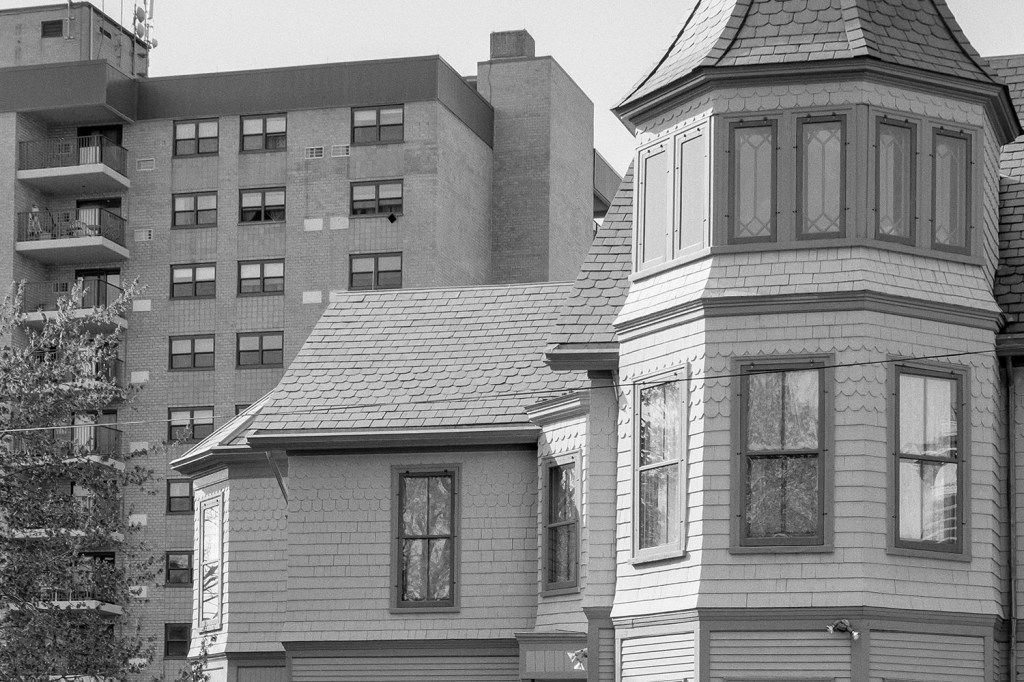Modernism arrived in Peekskill, N.Y., a Hudson River Valley town 60 miles north of New York City, in the 1960s.
Renewal through demolition opened up the opportunity to impose a new order on Peekskill, a view that presents itself the moment one steps outside the Peekskill Museum. The 1878 building that houses the museum—all gables and turrets and yellow- and green-shingled millwork—sits upon a hill. In its immediate background is a late- midcentury brick high-rise, rectilinear in form with small symmetrical windows and punched- out, boxy balconies. The scene recalls theorist Fredric Jameson’s Postmodernism , in which he writes about the construction of the Wells Fargo Tower in Los Angeles’ historic Bunker Hill neighborhood, observing that Modernism effectuated a “waning of historicity” and “depthlessness” of place.
The view makes manifest how far removed Peekskill is from its urban renewal–era recovery, and how far it still has to go. In addition to an increase in property crime, vandalism, and a rash of fires—documented in detail by former city historian John Curran in Old Peekskill’s Destruction in the 1960s and 1970s, By Urban Renewal, Fires, Riots and the Parking Authority —the city’s tax coffers rang hollow as its economic base imploded and government-owned and/or -run properties increasingly replaced the private sector. Today, though, emerging from its conflicted memories as a historic and “renewed” place, Peekskill can be seen as a city of juxtapositions now aiming to incorporate all of itself into a new identity.
In a demographic study produced by nonprofit Hudson Valley Pattern for Progress, looking at just the period 2000–2015, median household income in Peekskill “has fallen by 20 percent when accounting for inflation, while the poverty rate has edged up from 11 to 13 percent.” Since 1990, however, both property and violent crime rates have collapsed to minimal levels, and demographic change has occurred as both white and black populations have decreased while there has been a rise in the Hispanic population, from 22 percent to 37 percent.
Downtown, a derelict district in the late 1960s, now percolates with activity. Jim Pinto, Peekskill’s economic development director, can list off and speak in detail about any one of the many developments happening in the city. A couple of these are the Gateway Townhomes, which are 16 infill townhomes downtown, and One Park Place, a mixed-use high-rise from Long Island City–based Alma Realty, slated to bring 181 housing units and mezzanine outdoor dining to the downtown periphery. In addition, an RFP was recently issued for an old salvage yard where Pinto hopes to see proposals for hospitality, light manufacturing, or perhaps a recreational sports complex—things that are “both job opportunities and bring feet on the street,” he says.
Pinto speaks broadly of making Peekskill’s quality of life better, not only through building projects but by addressing underlying infrastructure needs. “The city is rebuilding sewage pumps stations and adding future connections to increase capacity. We’re leveraging infrastructure funding to rebuild in anticipation of future development,” Pinto says.
Jean Friedman, the city’s director of planning, references the city’s Downtown Design Guidelines as a way to ensure that the aesthetic intent of new development or rehab is compatible with the remaining historic stock to produce a complete city.
Ben Green is chair of Art Industry Media (AIM). In 1979, Green’s grandfather and father purchased the Peekskill Hat Factory building, a dilapidated and sparsely occupied industrial/commercial facility. In the ensuing years, Green has transformed the old brick building into a makerspace that is currently 100 percent occupied. AIM grew out of his and others’ work in bringing together Peekskill’s disparate creative, manufacturing, and legacy communities.
AIM’s goal is to position Peekskill—which is proximate to New York City, Grand Central Terminal being exactly one hour away on Metro-North—as a logical locale for a multimedia hub that attracts people who may have been priced out, and also provides opportunities for locals to become immersed and trained in the next phase of Peekskill’s small-scale economy, which, this time, will be media-driven rather than goods-based.
AIM intends to act as a radio, broadcasting the diversity of talent and opportunity that already exists in Peekskill—from MakerBot co- founder Bre Pettis’ presence, who is developing a high-tech ecosystem, to the Emmy-award- winning sound production company Alchemy Post Sound.
“We want to pull together folks in the creative industry and network these folks to those who are here,” Green says. “We don’t make stoves. We don’t make hats. America needs media. We’re putting together pipelines for kids to plug into, ideas to make old spaces like firehouses into places that provide the skills [to enter] into the media economy.” And perhaps reclaim Peekskill’s particular sense of place as it reframes the woes that wrought its renewal.
